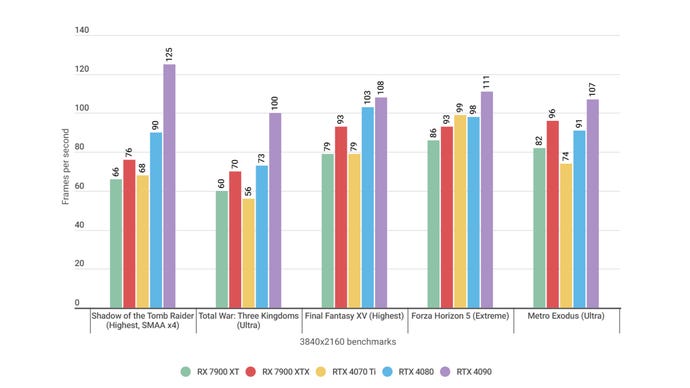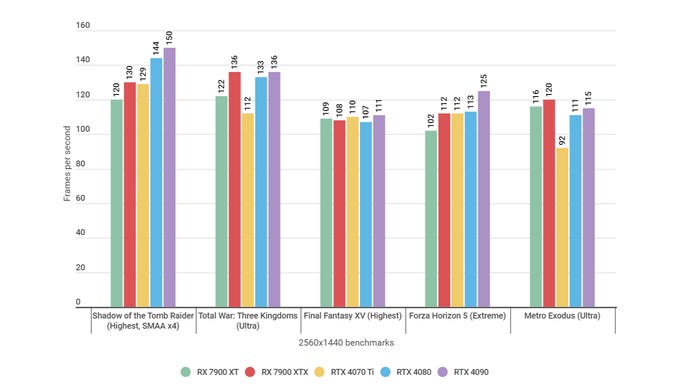Nvidia GeForce RTX 4080 review: Asking too much
Another super-strong RTX 40 graphics card you'd have to save big for
If you visited this URL in… oh bloody hell, November, you’ll know I have some ‘splaining to do. Basically I was only going to keep this RTX 4080 review as a review-in-progress until I cleared some other important hardware gubbins that was occurring that week, but then the AMD Radeon RX 7900 XT and RX 7900 XTX showed up and I thought "Well it’d be good to include benchmarks from those too", so I pushed it back until those were tested. Then the RTX 4070 Ti got announced and I thought "Well it’d be good to include benchmarks from that too", so pushed it back until that was tested. Which it has been, so here they are, a little late but fully formed: opinions on the RTX 4080.
It's not great. Or rather, it is literally great: this vast graphics card wouldn’t fit in my mid-tower case unless I removed the front fans and radiator, and it can sail through 4K like it’s a Venetian high street. But then, so can both of its much cheaper Radeon rivals, while the RTX 4070 Ti is a more accessible route into the best bits of Nvidia’s Ada Lovelace architecture – including DLSS 3.
Yes, money talk is dull, but most of the RTX 4080’s problems come down to its price. You’re looking at a starting point of £1269 / $1199, should you get your hands on an Nvidia-crafted Founders Edition model, while the Asus ROG Strix GeForce RTX 4080 OC Edition I tested is nearly RTX 4090 money: £1480 in the UK and $1550 in the States. For that, you get a GPU that consistently outperforms the RTX 3090 Ti, the previous GeForce top dog, but doesn’t pull out the borderline fantastical speeds it would need to make itself a good deal.
RTX 4080 review: 4K performance
The review-in-progress focused on the RTX 4080’s considerable FPS gains on the RTX 3090 Ti and its immediate predecessor, the RTX 3080. These still apply, from the 79% improvement in Shadow of the Tomb Raider to the 48% uplift in Metro Exodus (both on the RTX 3080), but compared more closely to the rest of this current GPU generation, the RTX 4080 lacks much to distinguish it. It only comes close to the RTX 4090’s level in a small handful of games at 4K, its natural home, and the £999 RX 7900 XTX often manages to either equal or beat it.


You could say it’s a sufficient step up from the RTX 4070 Ti. With only one outlier, Forza Horizon 5, the RTX 4080 is usually somewhere between 10-20fps quicker, and never dropped below a 60fps average in any of these test games. That’s at least worth taking into consideration if you’re dead set on a card with DLSS support and are willing to pay top coin for 4K (or ultrawide) capability.
At the same time, it’s not like the RTX 4070 Ti sweats to death at this resolution. That dip below a 60fps average only happened twice, in Total War: Three Kingdoms and F1 22, and in the latter's case that's easily amended with upscaling. And again, with Shadow of the Tomb Raider a sole exception, the RX 7900 XTX manages to either outpace the pricier RTX 4080, or come so close that the framerate difference between them isn’t visibly apparent.
However, the RTX 4080 does have AMD’s efforts beaten on ray tracing. Just like how the Ampere generation – that’s the RTX 30 series – licked competing Radeon GPUs whenever ray traced lighting, shadows or reflections were in play, Ada Lovelace makes further RT improvements, cushioning the blow whenever these settings try to take a bite out the RTX 4080’s overall performance.
Metro Exodus, for instance, dropped from 96fps on the RX 7900 XTX to 45fps once Ultra-quality ray tracing was added to the benchmark. The RTX 4080 had a lower starting point, 91fps, but averaged a significantly higher 62fps with ray tracing. Likewise, Watch Dogs Legion saw the RX 7900 XTX fall from 83fps to a barely lowly 35fps after applying Ultra-quality RT, but the RTX 4080 produced a smooth 46fps with ray tracing despite its 78fps being slower without.
I still don’t think that makes the RTX 4080 "worth it", though, not least because ray tracing is ultimately supported in only a small minority of games, and is deserving of the performance hit in fewer still. A more convincing argument in its favour would be DLSS, which doesn’t always produce faster framerates than AMD’s competing FSR, but does usually look better in terms of upscaling quality.
DLSS 3 is here, too, AI frame generation and all. Don’t worry, this doesn’t send an unsettling AI mimic into your PC to live commentate your mouse clicks: when frame generation is turned on, the card can add in surprisingly accurate, fully self-generated frames between the ones it renders the usual way. Loads more frames, no performance cost, except for a touch of added input lag.

What’s more, the RTX 4080 seems to extract more from DLSS 3 than its RTX 40 series brethren. In Cyberpunk 2077, all three of these cards have a tough time with Psycho-level ray tracing at native 4K, but by whacking DLSS 3 to Quality and enabling frame generation, the RTX 4080 leaps from 27fps to 82fps. That’s a 204% boost in a couple of clicks, and represents a starker improvement than the 136% gain I got on the RTX 4070 Ti and the 154% gain I got on the RTX 4090. Set upscaling to Performance mode, and that becomes a 278% improvement on the RTX 4080, versus 232% on the RTX 4070 Ti and 223% on the RTX 4090.
That’s pretty compelling, until yet again you remember what you’d be paying for the privilege. And when the RTX 4070 Ti can also leverage DLSS 3 to wrestle control of one of the toughest ray tracing implementations in all of PC gaming, at 4K, for hundreds of pounds/dollars less… do the percentages actually count for that much?
RTX 4080 review: 1440p performance
As a 100fps+ engine for 2560x1440, the RTX 4080 shimmies itself much closer to the RTX 4090 – though CPU bottlenecking is going to be more common an issue at this resolution, especially for the higher-end GPU that stands to lose more.


Then there’s the matter of the RX 7900 XTX. Again. Without ray tracing, the RTX 4080 is only really faster in Shadow of the Tomb Raider, and the AMD card ekes out numerous leads in return. Many of these are also minor, though it’s hard to ignore the RX 7900 XTX’s extra 22fps in Assassin’s Creed Valhalla. Also hard to ignore: the RX 7900 XT, which costs less than the XTX (starting from about £870 in the UK) yet is able to squeak ahead of the RTX 4080 in Valhalla, Metro Exodus, Watch Dogs Legion and Hitman 3. Or Hitman World of Assassination, as it's now called.
Once more, then, it’s up to that ray tracing advantage to mount a rescue. In Metro, this time at 1440p, enabling Ultra ray tracing knocked the RTX 4080 down from 111fps to 100fps: a mere 10% drop. Compare that to a 32% drop on the RX 7900 XTX (120fps to 82fps) and a 42% drop on the RX 7900 XT (116fps to 67fps) and it’s clear that Nvidia are getting the most value out of these enhanced effects.
It's a similar story in Watch Dogs Legion: average performance on the RTX 4080 fell by 25% after introducing Ultra ray tracing, down to 61fps from 81fps. That’s no small loss but is nonetheless dwarfed by the 34% hit on the RX 7900 XTX (87fps to 57fps) and the 40% hit on the RX 7900 XT (86fps to 52fps). It’s also slightly better than on the RTX 4070 Ti, which dropped from 80fps to 58fps, a 28% reduction.
To be a tad kinder to the RTX 4090, it’s inevitable that you’d have to pay more for a graphics card that ably supports top-of-the-line features and settings. Opt for an RX 7900 series model and it might not sit comfortably knowing that your card, possibly bought to get the most out of a 4K gaming monitor, is only third or fourth best on ray tracing and upscaling. If you’re going premium, why not go all the way?
But then, going all the way in this instance would be buying the RTX 4090, which for all its own issues around its devastating price tag, is at least the superlative performance option. Next to the RX 7900 series, and now the RTX 4070 Ti as well, the RTX 4080 is drastically more expensive, but only rarely reaches a performance level that adequately backs up that price tag.
The draw of DLSS 3 remains strong, especially now that the number of games supporting it is rising at a faster pace. But the RTX 4070 Ti also offers this at a much lower price, with a lower PSU requirement, and frankly with a better chance of fitting the damned thing inside your case. That’s the current-gen, 4K-ready GeForce GPU I’d go for right now, even if it too demands a hefty investment.









